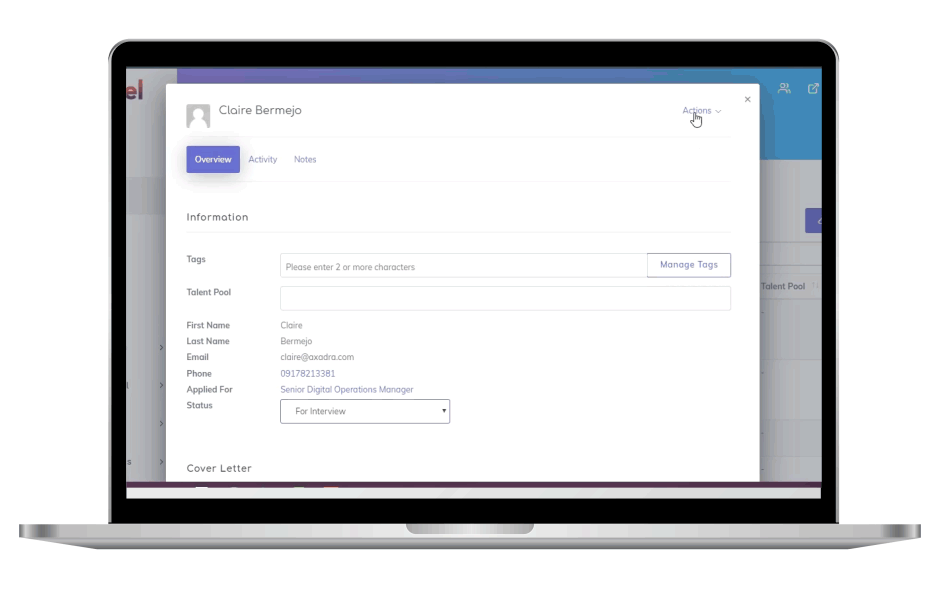As a recruitment officer, you might have encountered the terms recruitment and selection while trying to hire qualified candidates. These words are typically used throughout the hiring process and may even be interchanged with one another.
Although these two terms can be used to achieve the same end goal for your business—to find and bring in highly qualified individuals to the team—they are often defined differently. Another difference between recruitment and selection is the processes involved in each one.
Continue reading to learn more about how these two terms differ from each other. Finding out the differences between recruitment and selection can help you refine your hiring process even more.
What is Recruitment and Selection?
Recruitment and selection are both parts of a company’s employment process. These processes are crucial to ensure that you are hiring the right candidates for your organization.
The first term, recruitment, refers to the process of finding potential candidates and offering them a chance of getting hired for the open position in your company. Most of the time, recruiters reach out to job seekers by posting enticing job advertisements on various job portals.
Although recruitment might seem a simple process that recruiters can easily accomplish in a day, it involves different tasks that need to be accomplished to ensure effective recruitment. Here are some of the things that you need to do:
- Analysis of job requirements
- Advertisement of job openings
- Attracting interested candidates
- Managing applications sent in by candidates
- Screening applications from interested candidates
Selection, on the other hand, involves the process of finding a qualified candidate from a pool of talents. Your main goal is to screen each applicant and determine if they have the competencies and qualifications to fulfill the job needed in your organization.
Since the selection process requires you to look at every applicant in your talent pool, this process may consume a lot of time. Additionally, you also need to complete the following processes to ensure that the applicant you will hire is really qualified to fill the open position in your company:
- Candidate screening
- Eliminating non-qualified candidates
- Providing pre-employment examinations
- Conducting interviews
- Doing background and reference checks
- Evaluating medical tests
What is the difference between recruitment and selection?
Now that you have learned about the definitions of recruitment and selection, it is time to discuss the differences between these terms further. To make this easier for you, we have compared the characteristics of recruitment and selection and have presented them on this chart:
| Basis for Comparison | Recruitment | Selection |
| Meaning | Refers to the process of searching for potential candidates and encouraging them to apply. | An activity that involves selecting the best candidates among a list of applicants and offering them a job. |
| Approach | Positive: The main goal is to increase the number of individuals included in the talent pool. | Negative: The process aims to reduce the number of individuals in the talent pool until only one qualified candidate remains. |
| Objective | Advertise the job opening, entice individuals to apply, and build a talent pool using an online recruitment management software. | Find the most qualified candidate in the talent pool to fill the vacancies in an organization. |
| Key Factor | Job advertisement | Candidate appointment |
| Sequence | First | Second |
| Process | Recruitment is a simple process where the members of your hiring team do not consign themselves with scrutinizing candidates. They simply indicate that there are openings and encourage interested job seekers to apply. | In the selection process, your hiring staff should learn about every single detail of the candidates who applied for the opening. It is a much more complex process than recruitment. |
| Contractual Relation | Since recruitment only involves the advertisement of the open positions in an organization, potential candidates are not bound by any contractual relation with the hiring company. | Candidates who were considered qualified for the position will become a part of the hiring organization. Because of this, they will need to have a contractual agreement with their new employer. |
| Method | Economical: Most of the time, recruiters only need to post job advertisements on job portals, which are often free or cheap. | Expensive: Selection involves a thorough screening process that may require you to spend money on pre-employment assessment tests, background checks, and other selection tools. |
What are the different methods of recruitment?
Recruitment techniques are always evolving and there are many different types of recruitment that companies use to attract the best candidates. After all, not every job has the same requirements and each organization has different needs. Here are the different hiring tactics that employers use to find the candidates they’re looking for. Afterwards, we’ll discuss how the methods contribute to the difference between recruitment and selection.
Direct advertisements
This includes placing job ads on job boards, your Careers site, social media channels, and industry publications. This is an excellent way to find a large pool of talent, give exposure to employer branding, and boost your company’s overall reputation. While advertising can be expensive, you’ll reap its benefits as long as you target your ads well.
Employee referrals
Almost all companies have some type of employee referral program in place. The value is that it’s cost-effective, efficient, and you can trust in your employees that they’ll refer suitable candidates. Additionally, the new hire will likely already know more about your company compared to an outside hire and they’ll fit in better with the company culture.
Boomerang employees
Boomerang employees are those people who worked for your company before but left on good terms for personal reasons. There’s value in rehiring them because you know what they’re capable of and the employee already knows what’s it like to work for you. They’ll fit right back into the company culture. Rehiring past employees also reduces time to hire and cost per hire plus it eliminates the risks of you making a bad hire.
Talent pool databases
You should always search your existing talent pool databases for candidates who didn’t get hired before but showed potential. If you’ve been using a free online recruitment software, it’s easy to keep track of past applicants. When a new opening comes up, simply search your talent pool for candidates with skills and experience who fit the requirements. You’ll save yourself a lot of time and effort.
Promotions and transfers
While promotions and transfers aren’t necessarily the same thing, the concept is the same. You identify internal employees to fill in open roles. While a promotion means someone moves up the career ladder and is given a pay increase along with additional responsibilities, a transfer is a horizontal move that seldom involves added compensation or greater responsibility.
Recruitment events
For big companies or large organizations planning expansion, recruitment events are great for attracting qualified candidates, especially fresh graduates. Events can range from holding hackathons, recruitment drives on universities, hosting open days, or setting up a booth at job fairs.
What about the different methods of selection?
As you’ve probably deduced from the list above, recruitment is really all about gathering as many candidates as possible. The true difference between recruitment and selection then lies in the way both processes are handled. If recruitment is all about amassing a huge talent pool, selection is all about reducing that talent pool so that you’re only left with the most qualified candidates.
Here are the various methods of selection that hiring teams use.
Preliminary interview
The purpose of a preliminary interview is to basically eliminate unqualified candidates based on the information supplied in resumes or CVs. The objective is to reject misfits or applicants who don’t possess the necessary skills or credentials. Preliminary interviews are also often called courtesy interviews as they’re a good way to establish rapport and practice good public relations.
Skills Test and Psychometric Testing
Job seekers who pass the preliminary interviews are often called in for tests. Depending on the position and the company, there are various types of tests conducted. Popular examples include Personality Tests, Aptitude Tests, Integrity Tests, and Ability Tests. These help the hiring team objectively measure how well a candidate can perform tasks related to the job. It also helps determine if the candidate will be a good culture fit for the company.
Employment interview
The next step in selection is the employment interview, which is typically a formal and in-depth conversation that determines an applicant’s acceptability. It’s considered as the ultimate selection device. However, interviewers might evaluate candidates in a subjective manner. This makes it difficult to take what they say at face value. A good practice is creating a standardized interview guide that includes a detailed scoring criteria and pre-determined questions. This ensures you ask each candidate the same questions and remain as objective as possible.
Reference and background checks
Reference and background checks go beyond just being formalities. They’re an effective way of revealing valuable information that can help you identify top talent and better grasp how a candidate would transition into the new role. Checking references and background credentials also allows you to discover more about candidates and their work ethics. This is also a practice that highlights a difference between recruitment and selection: the ability to pinpoint red flags in the employee selection process.
However, checking references take a lot of time and effort – especially when you’re hiring for several vacant positions at a time. But you can make it worth your while by focusing on questions that provide more insight into a candidate’s accomplishments, weaknesses, and overall performance. For instance, avoid asking closed questions that only require a yes or no answer. Those often don’t offer useful information. Good questions include “Would you rehire them?” or “How did the candidate carry out his role and responsibilities?”
Recruitment vs Selection: Which one is better?
In order to find the best employees for your company, there shouldn’t be a recruitment vs selection debate. Why? Because they’re both intrinsically different processes and you need both if you want your hiring efforts to succeed.
Recruitment, as the name implies, focuses on finding candidates and making them apply for openings. Selection is all about picking the most qualified candidates among the talent pool you’ve built. They go hand-in-hand. However, while the recruitment process is often straightforward, the selection process is often unique to an organization. The best format for yours depends on many factors so it’s best to form a process that’s reliable, predictive, and suitable for the roles you need to hire for.
While there are many differences between recruitment and selection, at the end of the day, your hiring team needs both to onboard new employees and fill the gaps in your organization. All companies try to hire the best employees and if you want to do the same, don’t pit selection and recruitment against each other. You need recruitment to gather as many applicants as possible, and selection to help narrow down potential candidates. When you know how to master both, you’ll have a well-oiled hiring process that lets you onboard top talent and grow your organization’s potential to the fullest.














